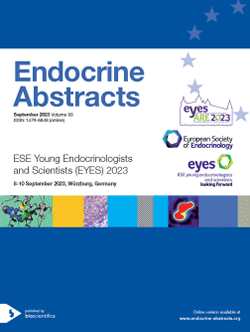
ESE Young Endocrinologists and Scientists (EYES) 2023
ESE Young Endocrinologists and Scientists (EYES) 2023
Oral communication 4: Pituitary and Neuroendocrinology
ea0093oc22 | Oral communication 4: Pituitary and Neuroendocrinology | EYES2023
Comparative evaluation of diagnostic performance of the most commonly used screening tests for pathological hypercortisolism: A single centre analysis
Efthymiadis Agathoklis , Loo Helen , Shine Brian , Tomlinson Jeremy , Pal Aparna , Pofi Riccardo
ea0093oc23 | Oral communication 4: Pituitary and Neuroendocrinology | EYES2023
Different molecular forms of pituitary adenomas, explaining behavior and prognosis. A new concept
Corlan Ana-Silva , Cimpean Anca Maria , Raica Marius
ea0093oc24 | Oral communication 4: Pituitary and Neuroendocrinology | EYES2023
Transcriptome in paraffin samples for the diagnosis and prognosis of pituitary neuroendocrine tumors (PITNETS)
Benanteur Nesrine , Villa Chiara , Birtolo Maria Francesca , Jouinot Anne , De Murat Daniel , Letourneur Franck , Gaillard Stephan , Raffin-Sanson Marie-Laure , Emile Jean-Francois , Bertherat Jerome , Baussard Bertrand , Assie Guillaume
ea0093oc25 | Oral communication 4: Pituitary and Neuroendocrinology | EYES2023
The genetic background of acromegaly in a tertiary referral centre in Krakow, Poland
Bogusławska Anna , Godlewska Magdalena , Rzepka Ewelina , Korbonits Marta , Hubalewska-Dydejczyk Alicja , Gilis-Januszewska Aleksandra
ea0093oc26 | Oral communication 4: Pituitary and Neuroendocrinology | EYES2023
Whole blood transcriptomic signature of Cushing’s syndrome
Birtolo Maria Francesca , Armignacco Roberta , Benanteur Nesrine , De Murat Daniel , Guignat Laurence , Groussin Lionel , Libe Rossella , Letourneur Franck , Bertherat Jerome , Jouinot Anne , Assie Guillaume
ea0093oc27 | Oral communication 4: Pituitary and Neuroendocrinology | EYES2023
The role of the GH receptor polymorphisms as a prognostic factor of vertebral fractures in acromegalic patients resistant to first-generation SSAs and treated with Pegvisomant or Pasireotide Lar
Costanza Flavia , Chiloiro Sabrina , Giampietro Antonella , Mattogno Pier Paolo , Infante Amato , Angelini Flavia , Lauretti Liverana , Olivi Alessandro , Pontecorvi Alfredo , Doglietto Francesco , De Marinis Laura , Bianchi Antonio
ea0093oc28 | Oral communication 4: Pituitary and Neuroendocrinology | EYES2023
Hepatic Steatosis Index as a non-invasive marker for liver steatosis in patients with endogenous Cushing Syndrome, ERCUSYN Krakow database
Minasyan Mari , Gamrat Aleksandra , Hubalewska-Dydejczyk Alicja , Valassi Elena , Gilis-Januszewska Aleksandra
ea0093oc29 | Oral communication 4: Pituitary and Neuroendocrinology | EYES2023
Folliculo-stellate cells in nonfunctioning pituitary neuroendocrine tumors
Nastase Valeria Nicoleta , Burcea Iulia Florentina , Ceausu Amalia Raluca , Poiana Catalina , Raica Marius



